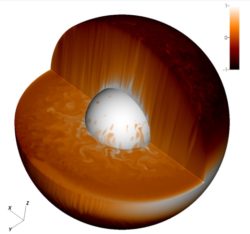Laterally Varying Convection in Earth’s Core
- Academic lead
- Jon Mound (Earth and Environment)
- Co-supervisor(s)
- Chris Davies (Earth and Environment), Steve Tobias (Mathematics)
- Project themes
- Geophysical and Astrophysical Flows
Convection within Earth’s fluid core generates the planetary magnetic field; spatial and temporal variations of the geomagnetic field can thus be used to gain insight into the dynamics of this otherwise inaccessible region. Seismic, geomagnetic, and geodynamic observations indicate that lateral variations in heat flow are imposed on the core at the top, and possibly bottom, boundary. These forcings, together with free convection, produce a rich variety of dynamical behaviour.
Previous simulations by the group in Leeds indicate that the inclusion of laterally varying boundary conditions at the top and bottom of the fluid core can significantly reorganise the pattern of convection; for example, some geophysically realistic scenarios produce relatively quiescent regions at the top of the core where thermal stratification suppresses convection, juxtaposed beside regions of vigorous turbulent convection. This project will combine numerical and theoretical analysis to produce a systematic study of the influence of boundary control on the dynamics of non-magnetic convection within a rotating fluid shell and extrapolate to Earth-like conditions to investigate the potential for these dynamics to explain observed features of the Earth’s magnetic field. Depending on the project trajectory and student interests, comparison with laboratory experiments is possible.

Figure 1: Output from a simulation of rotating convection with lateral boundary heating. Colours represent temperatures (dark = cold, light = hot).
